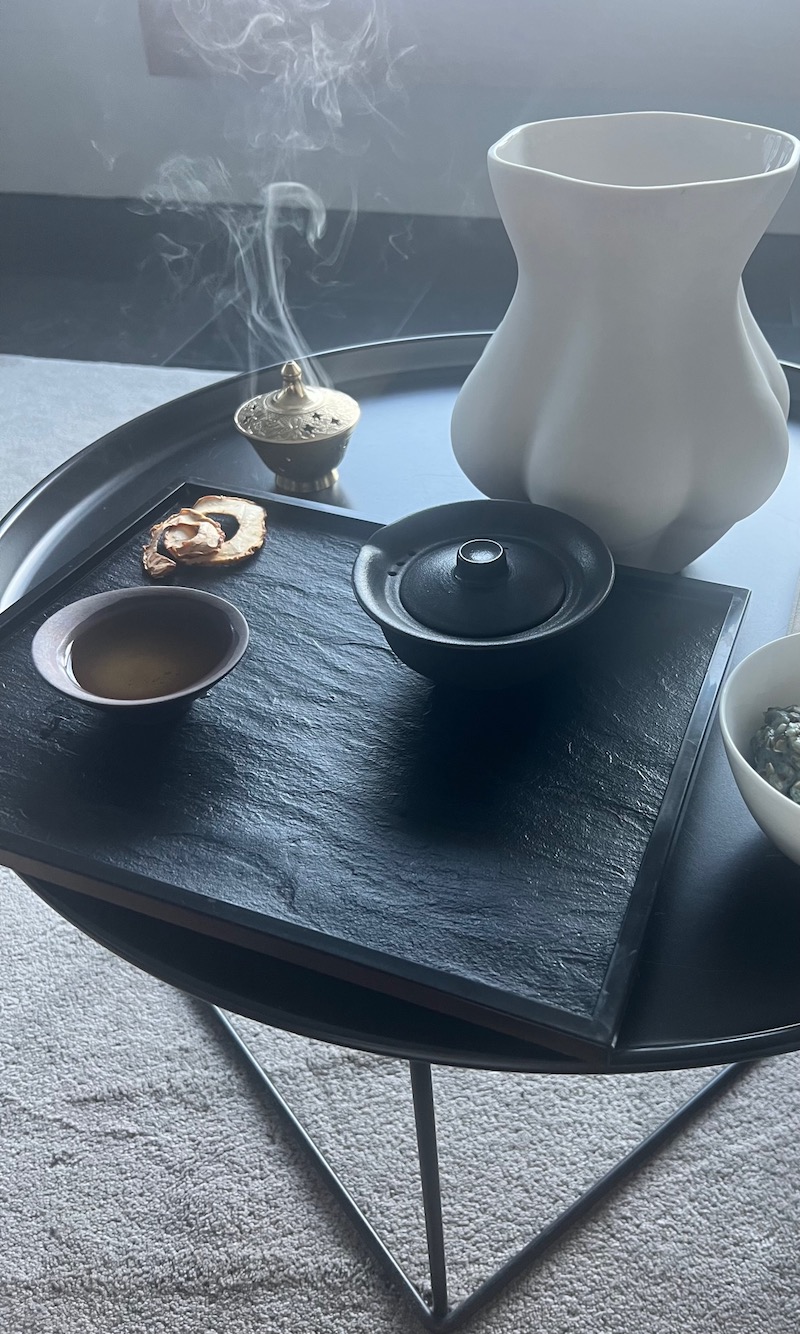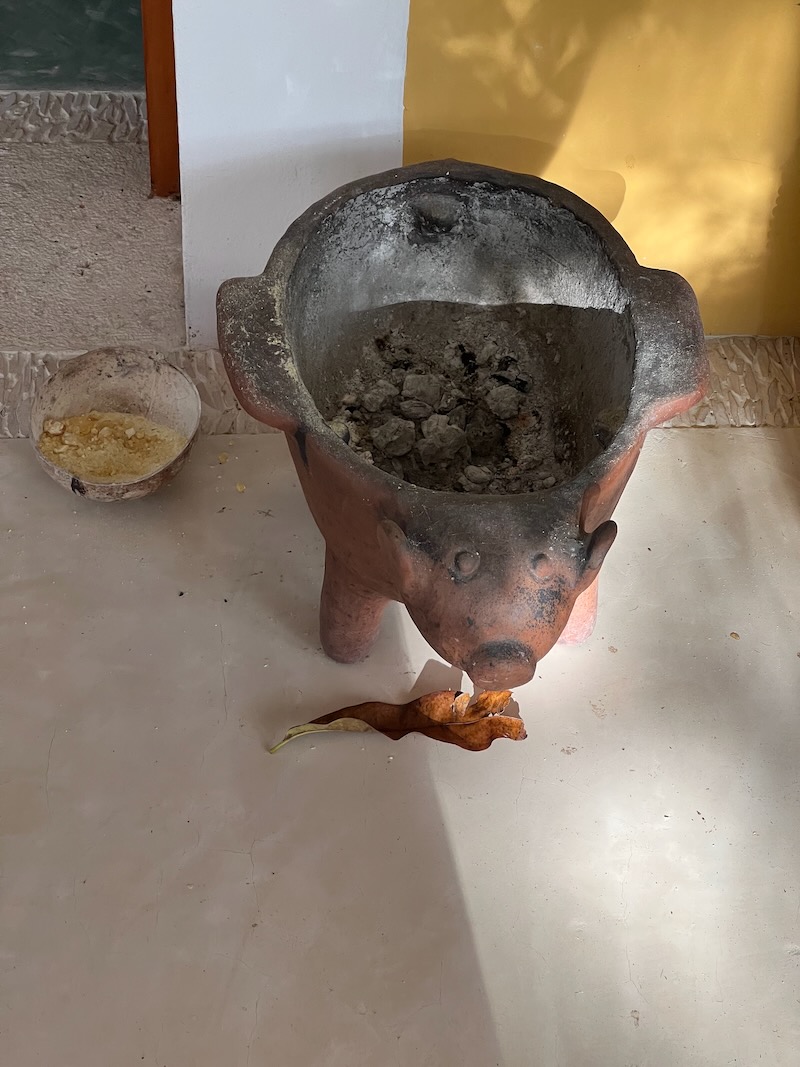Incense
This poem was inspired by an incense. The plant mass of burning ash I often light when writing indoors. Older than a candle and spread east to west, this smoky device has been used in spiritual ceremonies, in tribal rites, to commemorate the deceased and to clear the surroundings of bad spirits. Today it is more widely spread in the western meditation practice, in more intimate yoga studios, in wholesome tea rooms that I love to ground myself in, but the more in the zeitgeist concept stores I come by, the more incenses I find. Its scent thickens the atmosphere with grounding presence.


sage dilates my nostrils, burning
flesh to ashes penetrates me viscerally
cheeks swell like a blushing cherry
the smoking air, strong, pulls the lace
around my breasts for the lungs to embrace
the longing heart’s shivering body of nerves
this oxygen-bound, dried mist of a tamed blaze
travels through my aching body filled with life
reminding me to cede all that useless strife
— by breath alone come out of the maze
you were caught in weak like a mice
lost in the vain mind throwing dice
oh, this delicate life seeming at ease
dependent on timely contraction and release
on what goes in and what comes out as I float
above, I see clear, it’s joy that makes it count
~ Joy
The shape of this poem (on a computer screen for mobile turn your phone to horizontal) is intentionally mimicking the fuming incense first from the left and further down from its right side border.


My use of the incense is purely practical. The smoke relaxes me, it helps me to focus, it eases any lingering anxiety and thoughts, plus it smells so nice. While I have never inhaled a draw from a cigarette (it just smells terrible, how could I?), I shared some bonding rounds of scented hookah lounging on divans from Abu Dhabi, through Istanbul, Marrakech to London. My one and only puff of marijuana concluded in ceaseless raptures of irrational laughter I puzzlingly did not enjoy. The fake effect of joy from it put me off. I prefer being connected, not disjointed from myself. I want to feel the real or the imagined, but with the sole aid of my own creative mind.
The only smoke I truly relish is that of the 6000 years old ceremonial tool that was the very first fragrant material used by humans. The ancient Chinese and the Egyptians burned plants to induce the specific smell bound in them. It is like liberating the aroma’s spirit dwelling inside. I spent much of my 20s living in Asia where burning incense accompanied many of my adventures. In the Buddhist temples on the Kumano Kodo in Japan, the stupas scattered around the bustling Bangkok, the tranquil Luang Prabang, the uncountable Hindu divinities’ shrines in Nepal and India, taoist edifices around Hong Kong, Shanghai and Taipei.
The Japanese refined the ritualistic incense ceremony into kōdō that similarly to tea ceremony chadō induces the zen tranquility of the mind. Recently, I was drown to the Earth element made of vetiver, cypress and patchouli stirred in the area of an ancient rainforest in Guatemala of the Nippon Kodo incense maker that has been in business in Tokyo since 1575. The infatuation with incense has never ceased to work on us spiritually.


From the lonely mountain chapels to the urban hustle, the incense scent’s omnipresence filled me with calm. The smoky indescribable energy works its magic anywhere — from your bathroom to your desk. One does not need to burn it in a dedicated sacred place.
I learned from an interview with a contemporary LA-based artist of my vintage (’83 has rather pleased from Australia through France, Italy to Cali), that I am not a lone creative in this incense sway. Some use it while painting, others when taking their meditative break or sipping tea to keep their spirits high in the creation unique to their own kind. The scent of good coffee is a sensuous realm on its own, its force just clashes too harsh with an incense to my sensitive nose.


The forms of an incense
An incense as a source of pleasant smoke does not have to be shaped into a stick. Bound or ground dried plants like holy basil and sage packs are used for scent releasing by burning. Even resinous materials like the oliban of the boswellia tree family found in Northern Africa. Any decent Arabic market sells them, I bought my first such incense in Marrakech. One needs a coin-shaped charcoal and a lidded censer pierced with openings for the smoke to come out and to burn it safely. The last tool I only acquired recently. While traveling from Northern Italy through the mountain pass into the Swiss Engadine, at my request we stopped at a UNESCO protected nunnery dedicated to St. John, where next to jams, herbal tisanes, and cookies made by the nuns, they also sold packets of blended incense. Their ‘Paradise mix’ intrigued me (the irresistible promise of heaven!), so I snapped it together with a gold-leaf censer small enough for travelling and easy to put on an even surface anywhere. Our winter mountain retreat smelled divine the entire month.
At the Met museum on Manhattan I witnessed splendid incense burners. The bronze art works were inspired by animals like a bull and cat. Imagine the fumes coming off their eyes and nostrils!

Large, suspended from the ceiling or handheld censers are still being used during religious ceremonies. From orthodox churches, mosques to catholic cathedrals. In Mexico they penetrated the everyday presence as scent accompanies the soul to a reflective realm affecting human wellness. We need the spiritual in life, it does not have to be religious, but it must be present to comfort us in the turmoil that existence in flesh, wood, or fibre is.

